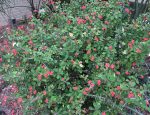
Native to Madagascar, this evergreen semi-succulent shrub is a member of the spurge family, Euphorbaceae, that also includes pointsettia, croton, and castor oil plant. The plants grow up to 6′ tall and have thick fleshy grayish-brown stems that are branched, 3-5 angled, and covered with 1″ long spines/thorns. The obobate , bright green to gray-green leaves are up to 6″ong, arranged sprirally, and tend to be just on the branch tips. The inconspicuous flowers are 1″ wide, have showy yellow or red bracts, and may appear all year. Photo Credit Wikipedia
In Matthew 27 we read about the treatment of Jesus by the soldiers of Pontius Pilate before the crucifixion:

“Then the soldiers of the governor took Jesus into the Praetorium and gathered the whole garrison around Him. And they stripped Him and put a scarlet robe on Him. When they had twisted a crown of thorns, they put it on His head, and a reed in His right hand. And they bowed the knee before Him and mocked Him, saying, “Hail, King of the Jews!”
The English translation of the “crown of thorns” is controversial and authorities do not agree on what plant is meant. The common name is the only reason to grow this plant in a Mary garden since it could not have been used as material for the real crown of thorns because it was not known in ancient Palestine during the time of Christ. The plant that provided the crown of thorns was most likely Jerusalem thorn, Paliurus spina-christi, as it pliable enough to make into a crown. This plant, however, is rare in Palestine. Jujube, Zizyphus spina-christi, has also been suggested as the source of the crown of thorns but is rejected by many authorities because it is too brittle to be woven into a crown. On the other hand, it is very common in in the old city of Jerusalem especially near the place that is thought to have been Golgotha.
Crown of thorns can be grown in full sun to partial shade and sandy, well-drained soil in USDA Hardiness Zones 9-10 but can be grown as a house plant. If grown as a house plant feed 10:10:10 weakly weekly and reduce water in the winter. It is generally healthy and has no significant pests or diseases. Plants are most easily propagated by stem cuttings. For gardeners living in warm climates plants can be used for hedges as well as for xeriscaping in rock gardens and seaside gardens. All parts of the plant are poisonous if ingested and the milky sap from the stems may irritate the skin. The plant is considered to be sacred in the Bathouist religion of the Bodo people of Assam, West Bengal, Nagaland and Nepal and symbolises the supreme deity, Bathoubwrai (Master of the Five Elements).
The genus name, Euphorbia, honors Euphorbus, the ancient Greek herbalist and personal physician of Juba II (r. 30 BC – 25 BC), King of Mauretania, an area in North Africa. The specific epithet, milii, honors M. le baron Milius, Governor of Île Bourbon, present-day Île de la Réunion (Reunion Island) who may have introduced the plant into France in 1821. The varietal name, splendens, comes from the Latin word splendeo meaning shine.